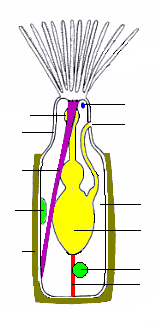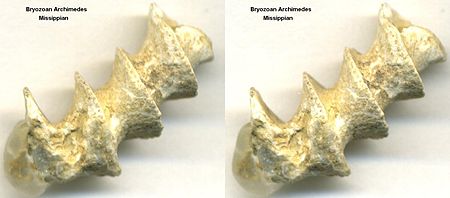Bryozoa
| Bryozoa Temporal range: Contested Cambrian records (Pywackia, Protomelission[3])
| |
|---|---|

| |
| "Bryozoa", from Ernst Haeckel's Kunstformen der Natur, 1904 | |
| Scientific classification | |
| Domain: | Eukaryota |
| Kingdom: | Animalia |
| Clade: | Lophophorata |
| Phylum: | Bryozoa Ehrenberg, 1831[4] |
| Classes | |
| Synonyms[5] | |
|
Ectoprocta (Nitsche, 1869) (formerly subphylum of Bryozoa) | |
Bryozoa (also known as the Polyzoa, Ectoprocta or commonly as moss animals)
The terms Polyzoa and Bryozoa were introduced in 1830 and 1831, respectively.[10][11] Soon after it was named, another group of animals was discovered whose filtering mechanism looked similar, so it was included in Bryozoa until 1869, when the two groups were noted to be very different internally. The new group was given the name "Entoprocta", while the original Bryozoa were called "Ectoprocta". Disagreements about terminology persisted well into the 20th century, but "Bryozoa" is now the generally accepted term.[12][13]
Colonies take a variety of forms, including fans, bushes and sheets. Single animals, called
Each zooid consists of a "cystid", which provides the body wall and produces the
Predators of marine bryozoans include
Mineralized skeletons of bryozoans first appear in rocks from the Early
Description
Distinguishing features
Bryozoans,
Entoprocts, another phylum of filter-feeders, look rather like bryozoans but their lophophore-like feeding structure has solid tentacles, their anus lies inside rather than outside the base of the "crown" and they have no coelom.[21]
| Bryozoa[17](Ectoprocta) | Other lophophorates[22] |
Other Lophotrochozoa | Similar-looking phyla | |||
|---|---|---|---|---|---|---|
Phoronida[18] |
Brachiopoda[19] |
Annelida, Mollusca |
Entoprocta[21] | Corals (class in phylum Cnidaria)[20] | ||
| Coelom | Three-part, if the cavity of the epistome is included | Three-part | One per segment in basic form; merged in some taxa | none | ||
| Formation of coelom | Uncertain because metamorphosis of larvae into adults makes this impossible to trace | Enterocoely | Schizocoely | not applicable | ||
| Lophophore | With hollow tentacles | none | Similar-looking feeding structure, but with solid tentacles | none | ||
| Feeding current | From tips to bases of tentacles | not applicable | From bases to tips of tentacles | not applicable | ||
Multiciliated cells in epithelium
|
Yes[23] | no[23] | Yes[23] | not applicable | ||
| Position of anus | Outside base of lophophore | Varies, none in some species | Rear end, but none in Siboglinidae | Inside base of lophophore-like organ | none | |
| Colonial | Colonies of clones in most; one solitary genus | Sessile species often form clumps, but with no active co-operation |
Colonies of clones in some species; some solitary species | Colonies of clones | ||
| Shape of founder zooid | Round, unlike normal zooids[20] | not applicable | Same as other zooids | |||
| Mineralized exoskeletons | Some taxa | no | Bivalve -like shells |
Some sessile annelids build mineralized tubes;[24] most molluscs have shells, but most modern cephalopods have internal shells or none.[25] | no | Some taxa |
Types of zooid
All bryozoans are colonial except for one genus, Monobryozoon.[26][27] Individual members of a bryozoan colony are about 0.5 mm (1⁄64 in) long and are known as zooids,[17] since they are not fully independent animals.[28] All colonies contain feeding zooids, known as autozooids. Those of some groups also contain non-feeding heterozooids, also known as polymorphic zooids, which serve a variety of functions other than feeding;[27] colony members are genetically identical and co-operate, rather like the organs of larger animals.[17] What type of zooid grows where in a colony is determined by chemical signals from the colony as a whole or sometimes in response to the scent of predators or rival colonies.[27]
The bodies of all types have two main parts. The cystid consists of the body wall and whatever type of
Feeding zooids
The most common type of zooid is the feeding autozooid, in which the polypide bears a "crown" of hollow tentacles called a lophophore, which captures food particles from the water.[27] In all colonies a large percentage of zooids are autozooids, and some consist entirely of autozooids, some of which also engage in reproduction.[31]
The basic shape of the "crown" is a full circle. Among the
The lophophore and mouth are mounted on a flexible tube called the "invert", which can be turned inside-out and withdrawn into the polypide,[17] rather like the finger of a rubber glove; in this position the lophophore lies inside the invert and is folded like the spokes of an umbrella. The invert is withdrawn, sometimes within 60 milliseconds, by a pair of retractor muscles that are anchored at the far end of the cystid. Sensors at the tips of the tentacles may check for signs of danger before the invert and lophophore are fully extended. Extension is driven by an increase in internal fluid pressure, which species with flexible exoskeletons produce by contracting circular muscles that lie just inside the body wall,[17] while species with a membranous sac use circular muscles to squeeze this.[30] Some species with rigid exoskeletons have a flexible membrane that replaces part of the exoskeleton, and transverse muscles anchored on the far side of the exoskeleton increase the fluid pressure by pulling the membrane inwards.[17] In others there is no gap in the protective skeleton, and the transverse muscles pull on a flexible sac which is connected to the water outside by a small pore; the expansion of the sac increases the pressure inside the body and pushes the invert and lophophore out.[17] In some species the retracted invert and lophophore are protected by an operculum ("lid"), which is closed by muscles and opened by fluid pressure. In one class, a hollow lobe called the "epistome" overhangs the mouth.[17]
The gut is U-shaped, running from the mouth, in the center of the lophophore, down into the animal's interior and then back to the anus, which is located on the invert, outside and usually below the lophophore.[17] A network of strands of mesothelium called "funiculi" ("little ropes")[33] connects the mesothelium covering the gut with that lining the body wall. The wall of each strand is made of mesothelium, and surrounds a space filled with fluid, thought to be blood.[17] A colony's zooids are connected, enabling autozooids to share food with each other and with any non-feeding heterozooids.[17] The method of connection varies between the different classes of bryozoans, ranging from quite large gaps in the body walls to small pores through which nutrients are passed by funiculi.[17][30]
There is a nerve ring round the pharynx (throat) and a
The solitary individuals of Monobryozoon are autozooids with pear-shaped bodies. The wider ends have up to 15 short, muscular projections by which the animals anchor themselves to sand or gravel[34] and pull themselves through the sediments.[35]
Avicularia and vibracula
Some authorities use the term avicularia (plural of
In vibracula, regarded by some as a type of avicularia, the operculum is modified to form a long bristle that has a wide range of motion. They may function as defenses against predators and invaders, or as cleaners. In some species that form mobile colonies, vibracula around the edges are used as legs for burrowing and walking.[17][31]
Structural polymorphs
Kenozooids (from the Greek kenós 'empty')[36] consist only of the body wall and funicular strands crossing the interior,[17] and no polypide.[27] The functions of these zooids include forming the stems of branching structures, acting as spacers that enable colonies to grow quickly in a new direction,[27][31] strengthening the colony's branches, and elevating the colony slightly above its substrate for competitive advantages against other organisms. Some kenozooids are hypothesized to be capable of storing nutrients for the colony. [37] Because kenozooids' function is generally structural, they are called "structural polymorphs."
Some heterozooids found in extinct trepostome bryozoans, called mesozooids, are thought to have functioned to space the feeding autozooids an appropriate distance apart. In thin sections of trepostome fossils, mesozooids can be seen in between the tubes that held autozooids; they are smaller tubes that are divided along their length by diaphragms, making them look like rows of box-like chambers sandwiched between autozooidal tubes. [38]
Reproductive polymorphs
Gonozooids act as brood chambers for fertilized eggs.[27] Almost all modern cyclostome bryozoans have them, but they can be hard to locate on a colony because there are so few gonozooids in one colony. The aperture in gonozooids, which is called an ooeciopore, acts as a point for larvae to exit. Some gonozooids have very complex shapes with autozooidal tubes passing through chambers within them. All larvae released from a gonozooid are clones created by division of a single egg; this is called monozygotic polyembryony, and is a reproductive strategy also used by armadillos.[39]
Cheilostome bryozoans also brood their embryos; one of the common methods is through ovicells, capsules attached to autozooids. The autozooids possessing ovicells are normally still able to feed, however, so these are not considered heterozooids. [40]
"Female" polymorphs are more common than "male" polymorphs, but specialized zooids that produce sperm are also known. These are called androzooids, and some are found in colonies of Odontoporella bishopi, a species that is symbiotic with hermit crabs and lives on their shells. These zooids are smaller than the others and have four short tentacles and four long tentacles, unlike the autozooids which have 15–16 tentacles. Androzooids are also found in species with mobile colonies that can crawl around. It is possible that androzooids are used to exchange sperm between colonies when two mobile colonies or bryozoan-encrusted hermit crabs happen to encounter one another. [41]
Other polymorphs
Spinozooids are hollow, movable spines, like very slender, small tubes, present on the surface of colonies, which probably are for defense.[42] Some species have miniature nanozooids with small single-tentacled polypides, and these may grow on other zooids or within the body walls of autozooids that have degenerated.[31]
Colony forms and composition
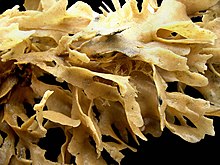

Although zooids are microscopic, colonies range in size from 1 cm (1⁄2 in) to over 1 m (3 ft 3 in).[17] However, the majority are under 10 cm (4 in) across.[20] The shapes of colonies vary widely, depend on the pattern of budding by which they grow, the variety of zooids present and the type and amount of skeletal material they secrete.[17]
Some marine species are bush-like or fan-like, supported by "trunks" and "branches" formed by kenozooids, with feeding autozooids growing from these. Colonies of these types are generally unmineralized but may have exoskeletons made of chitin.[17] Others look like small corals, producing heavy lime skeletons.[43] Many species form colonies which consist of sheets of autozooids. These sheets may form leaves, tufts or, in the genus Thalamoporella, structures that resemble an open head of lettuce.[17]
The most common marine form, however, is encrusting, in which a one-layer sheet of zooids spreads over a hard surface or over seaweed. Some encrusting colonies may grow to over 50 cm (1 ft 8 in) and contain about 2,000,000 zooids.[17] These species generally have exoskeletons reinforced with calcium carbonate, and the openings through which the lophophores protrude are on the top or outer surface.[17] The moss-like appearance of encrusting colonies is responsible for the phylum's name (Ancient Greek words βρύον brúon meaning 'moss' and ζῷον zôion meaning 'animal').[44] Large colonies of encrusting species often have "chimneys", gaps in the canopy of lophophores, through which they swiftly expel water that has been sieved, and thus avoid re-filtering water that is already exhausted.[45] They are formed by patches of non-feeding heterozooids.[46] New chimneys appear near the edges of expanding colonies, at points where the speed of the outflow is already high, and do not change position if the water flow changes.[47]
Some freshwater species secrete a mass of gelatinous material, up to 1 m (3 ft 3 in) in diameter, to which the zooids stick. Other freshwater species have plant-like shapes with "trunks" and "branches", which may stand erect or spread over the surface. A few species can creep at about 2 cm (3⁄4 in) per day.[17]
Each colony grows by asexual budding from a single zooid known as the ancestrula,[17] which is round rather than shaped like a normal zooid.[20] This occurs at the tips of "trunks" or "branches" in forms that have this structure. Encrusting colonies grow round their edges. In species with calcareous exoskeletons, these do not mineralize until the zooids are fully grown. Colony lifespans range from one to about 12 years, and the short-lived species pass through several generations in one season.[17]
Species that produce defensive zooids do so only when threats have already appeared, and may do so within 48 hours.[27] The theory of "induced defenses" suggests that production of defenses is expensive and that colonies which defend themselves too early or too heavily will have reduced growth rates and lifespans. This "last minute" approach to defense is feasible because the loss of zooids to a single attack is unlikely to be significant.[27] Colonies of some encrusting species also produce special heterozooids to limit the expansion of other encrusting organisms, especially other bryozoans. In some cases this response is more belligerent if the opposition is smaller, which suggests that zooids on the edge of a colony can somehow sense the size of the opponent. Some species consistently prevail against certain others, but most turf wars are indecisive and the combatants soon turn to growing in uncontested areas.[27] Bryozoans competing for territory do not use the sophisticated techniques employed by sponges or corals, possibly because the shortness of bryozoan lifespans makes heavy investment in turf wars unprofitable.[27]
Bryozoans have contributed to carbonate sedimentation in marine life since the Ordovician period. Bryozoans take responsibility for many of the colony forms, which have evolved in different taxonomic groups and vary in sediment producing ability. The nine basic bryozoan colony-forms include: encrusting, dome-shaped, palmate, foliose, fenestrate, robust branching, delicate branching, articulated and free-living. Most of these sediments come from two distinct groups of colonies: domal, delicate branching, robust branching and palmate; and fenestrate. Fenestrate colonies generate rough particles both as sediment and components of stromatoporoids coral reefs. The delicate colonies however, create both coarse sediment and form the cores of deep-water, subphotic biogenic mounds. Nearly all post- bryozoan sediments are made up of growth forms, with the addition to free-living colonies which include significant numbers of various colonies. "In contrast to the Palaeozoic, post-Palaeozoic bryozoans generated sediment varying more widely with the size of their grains; they grow as they moved from mud, to sand, to gravel."[48]
Taxonomy
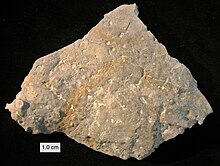
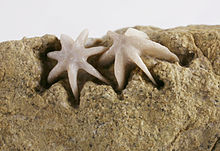
The phylum was originally called "Polyzoa", but this name was eventually replaced by Ehrenberg's term "Bryozoa".[13][49][50] The name "Bryozoa" was originally applied only to the animals also known as Ectoprocta (lit. 'outside-anus'),[51] in which the anus lies outside the "crown" of tentacles. After the discovery of the Entoprocta (lit. 'inside-anus'),[52] in which the anus lies within a "crown" of tentacles, the name "Bryozoa" was promoted to phylum level to include the two classes Ectoprocta and Entoprocta.[53] However, in 1869 Hinrich Nitsche regarded the two groups as quite distinct for a variety of reasons, and coined the name "Ectoprocta" for Ehrenberg's "Bryozoa".[5][54] Despite their apparently similar methods of feeding, they differed markedly anatomically; in addition to the different positions of the anus, ectoprocts have hollow tentacles and a coelom, while entoprocts have solid tentacles and no coelom. Hence the two groups are now widely regarded as separate phyla, and the name "Bryozoa" is now synonymous with "Ectoprocta".[53] This has remained the majority view ever since, although most publications have preferred the name "Bryozoa" rather than "Ectoprocta".[50] Nevertheless, some notable scientists have continued to regard the "Ectoprocta" and Entoprocta as close relatives and group them under "Bryozoa".[54]
The ambiguity about the scope of the name "Bryozoa" led to proposals in the 1960s and 1970s that it should be avoided and the unambiguous term "Ectoprocta" should be used.[55] However, the change would have made it harder to find older works in which the phylum was called "Bryozoa", and the desire to avoid ambiguity, if applied consistently to all classifications, would have necessitated renaming of several other phyla and many lower-level groups.[49] In practice, zoological naming of split or merged groups of animals is complex and not completely consistent.[56] Works since 2000 have used various names to resolve the ambiguity, including: "Bryozoa",[17][20] "Ectoprocta",[23][27] "Bryozoa (Ectoprocta)",[30] and "Ectoprocta (Bryozoa)".[57] Some have used more than one approach in the same work.[58]
The common name "moss animals" is the literal meaning of "Bryozoa", from Greek βρυόν ('moss') and ζῷα ('animals'), based on the mossy appearance of encrusting species.[59]
Until 2008 there were "inadequately known and misunderstood type species belonging to the Cyclostome Bryozoan family Oncousoeciidae."[60] Modern research and experiments have been done using low-vacuum scanning electron microscopy of uncoated type material to critically examine and perhaps revise the taxonomy of three genera belonging to this family, including Oncousoecia, Microeciella, and Eurystrotos. This method permits data to be obtained that would be difficult to recognize with an optical microscope. The valid type species of Oncousoecia was found to be Oncousoecia lobulata. This interpretation stabilizes Oncousoecia by establishing a type species that corresponds to the general usage of the genus. Fellow Oncousoeciid Eurystrotos is now believed to be not conspecific with O. lobulata, as previously suggested, but shows enough similarities to be considered a junior synonym of Oncousoecia. Microeciella suborbicularus has also been recently distinguished from O. lobulata and O. dilatans, using this modern method of low vacuum scanning, with which it has been inaccurately synonymized with in the past. A new genus has also been recently discovered called Junerossia in the family Stomachetosellidae, along with 10 relatively new species of bryozoa such as Alderina flaventa, Corbulella extenuata, Puellina septemcryptica, Junerossia copiosa, Calyptotheca kapaaensis, Bryopesanser serratus, Cribellopora souleorum, Metacleidochasma verrucosa, Disporella compta, and Favosipora adunca.[61]
Classification and diversity
Counts of formally described species range between 4,000 and 4,500.[62] The Gymnolaemata and especially Cheilostomata have the greatest numbers of species, possibly because of their wide range of specialist zooids.[27] Under the Linnaean system of classification, which is still used as a convenient way to label groups of organisms,[63] living members of the phylum Bryozoa are divided into:[17][27]
| Class | Phylactolaemata | Stenolaemata | Gymnolaemata | |
|---|---|---|---|---|
| Order | Plumatellida[64] |
Cyclostomatida | Ctenostomatida | Cheilostomata
|
| Environments | Freshwater |
Marine | Mostly marine | |
| Lip-like epistome overhanging mouth | Yes | none | ||
| Colony shapes | Gelatinous masses or tubular branching structures[65] | Erect or encrusting[66] | Erect, encrusting or free-living | |
| Exoskeleton material | Gelatinous or membranous; unmineralized | Mineralized | Chitin, gelatinous or membranous; unmineralized | Mineralized |
| Operculum ("lid") | none | none[66] (except in family Eleidae)[67] | None in most species | Yes (except in genus Bugula) |
| Shape of lophophore | U-shaped appearance(except in genus Fredericella, whose lophophore is circular) | Circular | ||
| How lophophore extended | Compressing the whole body wall | Compressing the membranous sac(separate inner layer of epithelium that lines the coelom) | Compressing the whole body wall | Pulling inwards of a flexible section of body wall, or making an internal sac expand. |
| Types of zooid | Autozooids only | Limited heterozooids, mainly gonozooids[68] | Stolons and spines as well as autozooids[68] | Full range of types |
Fossil record
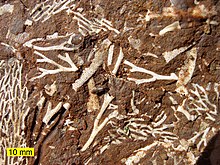
| Stereo image | |||
|---|---|---|---|
| |||
| |||
| |||
| |||
| Fossilized skeleton of Archimedes Bryozoan | |||
Fossils of about 15,000 bryozoan species have been found. Bryozoans are among the three dominant groups of Paleozoic fossils.[69] Bryozoans with calcitic skeletons were a major source of the carbonate minerals that make up limestones, and their fossils are incredibly common in marine sediments worldwide from the Ordovician onward. However, unlike corals and other colonial animals found in the fossil record, Bryozoan colonies did not reach large sizes.[70] Fossil bryozoan colonies are typically found highly fragmented and scattered; the preservation of complete zoaria is uncommon in the fossil record, and relatively little study has been devoted to reassembling fragmented zoaria.[71] The largest known fossil colonies are branching trepostome bryozoans from Ordovician rocks in the United States, reaching 66 centimeters in height.[70]
The oldest species with a
Evolutionary family tree
Scientists are divided about whether the Bryozoa (Ectoprocta) are a
Molecular phylogeny, which attempts to work out the evolutionary family tree of organisms by comparing their biochemistry and especially their genes, has done much to clarify the relationships between the better-known invertebrate phyla.[53] However, the shortage of genetic data about "minor phyla" such as bryozoans and entoprocts has left their relationships to other groups unclear.[54]
Traditional view
The traditional view is that the Bryozoa are a monophyletic group, in which the class
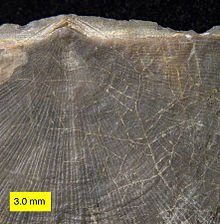
In 2009 another
Bryozoans' relationships with other phyla are uncertain and controversial. Traditional phylogeny, based on anatomy and on the development of the adult forms from embryos, has produced no enduring consensus about the position of ectoprocts.[23] Attempts to reconstruct the family tree of animals have largely ignored ectoprocts and other "minor phyla", which have received little scientific study because they are generally tiny, have relatively simple body plans, and have little impact on human economies – despite the fact that the "minor phyla" include most of the variety in the evolutionary history of animals.[79]
In the opinion of Ruth Dewel, Judith Winston, and Frank McKinney, "Our standard interpretation of bryozoan morphology and embryology is a construct resulting from over 100 years of attempts to synthesize a single framework for all invertebrates," and takes little account of some peculiar features of ectoprocts.[73]

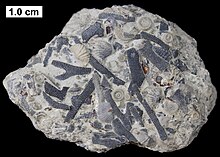
In ectoprocts, all of the larva's internal organs are destroyed during the metamorphosis to the adult form and the adult's organs are built from the larva's
Entoprocts
When entoprocts were discovered in the 19th century, they and bryozoans (ectoprocts) were regarded as classes within the phylum Bryozoa, because both groups were
From 1869 onwards increasing awareness of differences, including the position of the entoproct anus inside the feeding structure and the difference in the early pattern of division of cells in their embryos, caused scientists to regard the two groups as separate phyla,[54] and "Bryozoa" became just an alternative name for ectoprocts, in which the anus is outside the feeding organ.[53] A series of molecular phylogeny studies from 1996 to 2006 have also concluded that bryozoans (ectoprocts) and entoprocts are not sister groups.[54]
However, two well-known zoologists, Claus Nielsen and Thomas Cavalier-Smith, maintain on anatomical and developmental grounds that bryozoans and entoprocts are member of the same phylum, Bryozoa. A molecular phylogeny study in 2007 also supported this old idea, while its conclusions about other phyla agreed with those of several other analyses.[54]
Grouping into the Lophophorata
By 1891 bryozoans (ectoprocts) were grouped with phoronids in a super-phylum called "Tentaculata". In the 1970s comparisons between phoronid larvae and the cyphonautes larva of some gymnolaete bryozoans produced suggestions that the bryozoans, most of which are colonial, evolved from a semi-colonial species of phoronid.[80] Brachiopods were also assigned to the "Tentaculata", which were renamed Lophophorata as they all use a lophophore for filter feeding.[53]
The majority of scientists accept this,
If the grouping of bryozoans with phoronids and brachiopods into Lophophorata is correct, the next issue is whether the Lophophorata are protostomes, along with most invertebrate phyla, or deuterostomes, along with chordates, hemichordates and echinoderms.
The traditional view was that lophophorates were a mix of protostome and deuterostome features. Research from the 1970s onwards suggested they were deuterostomes, because of some features that were thought characteristic of deuterostomes: a three-part coelom; radial rather than spiral cleavage in the development of the embryo;
Lophophorate molecular phylogenetics
Molecular phylogeny analyses from 1995 onwards, using a variety of biochemical evidence and analytical techniques, placed the lophophorates as protostomes and closely related to
They are the only major phylum of exclusively clonal animals, composed of modular units known as zooids. Because they thrive in colonies, colonial growth allows them to develop unrestricted variations in form. Despite this, only a small number of basic growth forms have been found and have commonly reappeared throughout the history of the bryozoa.[69]
| Lophotrochozoa |
| ||||||||||||||||||||||||||||||
Ectoproct molecular phylogenetics
The phylogenetic position of the ectoproct bryozoans remains uncertain, but it remains certain that they belong to the Protostomia and more specifically to the Lophotrochozoa. This implies that the ectoproct larva is a trochophore with the corona being a homologue of the prototroch; this is supported from the similarity between the coronate larvae and the Type 1 pericalymma larvae of some molluscs and sipunculans, where the prototroch zone is expanded to cover the hyposphere.[83]
A study of the mitochondrial DNA sequence suggests that the Bryozoa may be related to the Chaetognatha.[84]
Physiology
Feeding and excretion
Most species are
In some species the first part of the stomach forms a muscular
There are no
Respiration and circulation
There are no respiratory organs, heart or blood vessels. Instead, zooids absorb oxygen and eliminate carbon dioxide through diffusion. Bryozoa accomplish diffusion through the use of either a thin membrane (in the case of anascans and some polyzoa) or through pseudopores located on the outer dermis of the zooid.[87] The different bryozoan groups use various methods to share nutrients and oxygen between zooids: some have quite large gaps in the body walls, allowing the coelomic fluid to circulate freely; in others, the funiculi (internal "little ropes")[33] of adjacent zooids connect via small pores in the body wall.[17][30]
Reproduction and life cycles
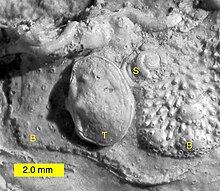
Zooids of all phylactolaemate species are simultaneous
All phylactolaemates and stenolaemates, and most gymnolaemates, exhibit placentation, and has therefore lecithotrophic (non-feeding) larvae. Except for Cyclostomata and the small gymnolaemate family Epistomiidae, which are viviparous, all are brooders. Phylactolaemata brood their embryos in an internal brood sac, but Gymnolaemata both external membranous sacs, skeletal chambers (ovicells) and internal brooding sacs exist.[88][89] The developing embryo relies on egg’s yolk, extraembryonic nutrition (matrotrophy) or both.[90]
In ctenostomes the mother provides a brood chamber for the fertilized eggs, and her polypide disintegrates, providing nourishment to the embryo. Stenolaemates produce specialized zooids to serve as brood chambers, and their eggs divide within this to produce up to 100 identical embryos.[27]
Planktotrophic (feeding) larvae are only found in class Gymnolaemata: In the cheilostomatan suborder Malacostegina they are found in the two families Membraniporidae and Electridae, and in the three ctenostome families Alcyonidiidae, Farrellidae, and Hislopiidae. In addition there are a few unconfirmed records, like the solitary form Aethozoid where larvae has never been observed, but which is assumed to have planktotrophic larvae.[91][92][93]
The
Bryozoan larvae vary in form, but all have a band of cilia round the body which enables them to swim, a tuft of cilia at the top, and an adhesive sac that everts and anchors them when they settle on a surface.
Phylactolaemates can also reproduce asexually by a method that enables a colony's lineage to survive the variable and uncertain conditions of freshwater environments.[27] Throughout summer and autumn they produce disc-shaped statoblasts, masses of cells that function as "survival pods" rather like the gemmules of sponges.[17] Statoblasts form on the funiculus connected to the parent's gut, which nourishes them.[27] As they grow, statoblasts develop protective bivalve-like shells made of chitin. When they mature, some statoblasts stick to the parent colony, some fall to the bottom ("sessoblasts"), some contain air spaces that enable them to float ("floatoblasts"),[17] and some remain in the parent's cystid to re-build the colony if it dies.[27] Statoblasts can remain dormant for considerable periods, and while dormant can survive harsh conditions such as freezing and desiccation. They can be transported across long distances by animals, floating vegetation, currents[17] and winds,[27] and even in the guts of larger animals.[95] When conditions improve, the valves of the shell separate and the cells inside develop into a zooid that tries to form a new colony. Plumatella emarginata produces both "sessoblasts", which enable the lineage to control a good territory even if hard times decimate the parent colonies, and "floatoblasts", which spread to new sites. New colonies of Plumatella repens produce mainly "sessoblasts" while mature ones switch to "floatoblasts".[85] A study estimated that one group of colonies in a patch measuring 1 square meter (11 sq ft) produced 800,000 statoblasts.[17]
Cupuladriid Bryozoa are capable of both sexual and asexual reproduction. The sexually reproducing colonies (aclonal) are the result of a larval cupuladriid growing into an adult stage whereas the asexual colonies(clonal) are a result of a fragment of a colony of cupuladriids growing into its own colony. The different forms of reproduction in cupuladriids are achieved through a variety of methods depending on the morphology and classification of the zooid.[96]
Ecology
Habitats and distribution
Most marine species live in tropical waters at depths less than 100 meters (330 ft; 55 fathoms). However, a few have been found in deep-sea trenches,[97] especially around cold seeps, and others near the poles.[98][99]
The great majority of bryozoans are
There are a variety of "free-living" bryozoans that live un-attached to a substrate. A few forms such as Cristatella can move. Lunulitiform cheilostomes are one group of free-living bryozoans with mobile colonies. They form small round colonies un-attached to any substrate; colonies of the genus Selenaria have been observed to "walk" around using setae.[104] Another cheilostome family, the Cupuladriidae, convergently evolved similarly shaped colonies capable of movement. When observed in an aquarium, Selenaria maculata colonies were recorded to crawl at a speed of one meter per hour, climb over each other, move toward light, and right themselves when turned upside-down.[105] Later study of this genus showed that neuroelectrical activity in the colonies increased in correlation with movement toward light sources. It is theorized that the capacity for movement arose as a side effect when colonies evolved longer setae for unburying themselves from sediment.[105]

Other free-living bryozoans are moved freely by waves, currents, or other phenomena. An Antarctic species, Alcyonidium pelagosphaera, consists of floating colonies. The pelagic species is between 5.0 and 23.0 mm (0.20 and 0.91 in) in diameter, has the shape of a hollow sphere and consists of a single layer of autozooids. It is still not known if these colonies are pelagic their whole life or only represents a temporarily and previously undescribed juvenile stage.[98][106] Colonies of the species Alcyonidium disciforme, which is disc-shaped and similarly free-living, inhabit muddy seabeds in the Arctic and can sequester sand grains they have engulfed, potentially using the sand as ballast to turn themselves right-side-up after they have been overturned. Some bryozoan species can form bryoliths, sphere-shaped free-living colonies that grow outward in all directions as they roll about on the seabed. [107]
In 2014 it was reported that the bryozoan
The phylactolaemates live in all types of freshwater environment – lakes and ponds, rivers and streams, and estuaries[65] – and are among the most abundant sessile freshwater animals.[77] Some ctenostomes are exclusively freshwater while others prefer brackish water but can survive in freshwater.[65] Scientists' knowledge of freshwater bryozoan populations in many parts of the world is incomplete, even in some parts of Europe. It was long thought that some freshwater species occurred worldwide, but since 2002 all of these have been split into more localized species.[65]
Bryozoans grow in clonal colonies. A larval Bryozoan settles on a hard substance and produces a colony asexually through budding. These colonies can grow thousands of individual zooids in a relatively short period of time. Even though colonies of zooids grow through asexual reproduction, Bryozoans are hermaphrodites and new colonies can be formed through sexual reproduction and the generation of free swimming larvae. When colonies grow too large, however, they can split in two. This is the only case where asexual reproduction results in a new colony separate from its predecessor. Most colonies are stationary. Indeed, these colonies tend to be settled on immobile substances such as sediment and coarse substances. There are some colonies of freshwater species such as Cristatella mucedo that are able to move slowly on a creeping foot.[109]
Interactions with non-human organisms

Marine species are common on
In freshwater, bryozoans are among the most important filter feeders, along with sponges and mussels.[115] Freshwater bryozoans are attacked by many predators, including snails, insects, and fish.[85]
In Thailand the introduced species Pomacea canaliculata (golden apple snail), which is generally a destructive herbivore, has wiped out phylactolaemate populations wherever it has appeared. P. canaliculata also preys on a common freshwater gymnolaemate, but with less devastating effect. Indigenous snails do not feed on bryozoans.[14]
Several species of the

In the
Some phylactolaemate species are intermediate hosts for a group of
Interaction with humans
Some fishermen in the
Marine bryozoans are often responsible for biofouling on ships' hulls, on docks and marinas, and on offshore structures. They are among the first colonizers of new or recently cleaned structures.[110] Freshwater species are occasional nuisances in water pipes, drinking water purification equipment, sewage treatment facilities, and the cooling pipes of power stations.[65][121]
A group of chemicals called bryostatins can be extracted from the marine bryozoan Bugula neritina. In 2001 pharmaceutical company GPC Biotech licensed bryostatin 1 from Arizona State University for commercial development as a treatment for cancer. GPC Biotech canceled development in 2003, saying that bryostatin 1 showed little effectiveness and some toxic side effects.[122] In January 2008 a clinical trial was submitted to the United States National Institutes of Health to measure the safety and effectiveness of Bryostatin 1 in the treatment of Alzheimer's disease. However, no participants had been recruited by the end of December 2008, when the study was scheduled for completion.[123] More recent work shows it has positive effects on cognition in patients with Alzheimer's disease with few side effects.[124] About 1,000 kilograms (2,200 lb) of bryozoans must be processed to extract 1 gram (1⁄32 oz) of bryostatin, As a result, synthetic equivalents have been developed that are simpler to produce and apparently at least as effective.[125]
See also
References
- ^ from the original on 7 June 2019. Retrieved 20 April 2018.
- S2CID 130040324.
- ^ S2CID 257425218.
- S2CID 129637643.
- ^ PMID 19475710.
- OCLC 1029265317.
- .
- ^ Key novelties in the evolution of the aquatic colonial phylum Bryozoa: evidence from soft body morphology
- ^ Aethozooides uraniae, a new deep-sea genus and species of solitary bryozoan from the Mediterranean Sea, with a revision of the Aethozoidae
- ^ Thompson, John V. (1830). "Memoir V: On Polyzoa, a new animal discovered as an inhabitant of some Zoophites". Zoological researches and illustrations; or Natural history of nondescript or imperfectly known animals. Cork, IE: King and Ridings. pp. 89–102.
- ^ Ehrenberg, Christian G. (1831). "Pars zoologica. Animalia evertebrata exclusis insectis [Invertebrata other than Insecta]". Symbolae physicae, seu lcones et descriptiones corporum naturalium novorum aut minus cognitorum (in Latin). Berolini Ex officina Academica. pp. 1–126.
- ^ Stebbing, T.R.R. (1911). "The terms Polyzoa and Bryozoa". Proceedings of the Linnean Society of London. Session 123 (Symposium): 61–72.
- ^ a b Muir-Wood, H.M. (1955). A history of the classification of the phylum Brachiopoda. London: British Museum (Natural History). p. 13.
- ^ a b Wood, T.S. (May 2006). "Heavy Predation on Freshwater Bryozoans by the Golden Apple Snail, Pomacea canaliculata" (PDF). Natural History Journal of Chulalongkorn University. 6 (1): 31–36. Archived from the original (PDF) on 6 October 2011. Retrieved 18 August 2009.
- ^ "Introduction to the Bryozoa". Berkeley, CA: University of California Museum of Paleontology. Archived from the original on 8 December 2019. Retrieved 8 December 2019.
- S2CID 240073948.
- ^ ISBN 978-0-03-025982-1.
- ^ ISBN 978-0-03-025982-1.
- ^ ISBN 978-0-03-025982-1.
- ^ ISBN 978-0-486-29371-4. Retrieved 7 August 2009.
- ^ ISBN 978-0-03-025982-1.
- ^ ISBN 978-0-03-025982-1.
- ^ PMID 21708765.
- ISBN 978-0-03-025982-1.
- ISBN 978-0-03-025982-1.
- ISBN 978-3-540-68657-6. Archivedfrom the original on 8 March 2023. Retrieved 7 July 2009.
- ^ ISBN 978-0-19-551368-4.
- ISBN 978-0-19-860613-0.
- ^ Bryozoans and Palaeoenvironmental Interpretation
- ^ ISBN 978-0470016176.
- ^ ISBN 978-0-226-56047-2. Archivedfrom the original on 8 March 2023. Retrieved 29 July 2009.
- (PDF) from the original on 9 October 2022. Retrieved 12 September 2009.
- ^ a b "funiculus". Random House Dictionary. Random House. Archived from the original on 13 May 2010. Retrieved 2 August 2009.
- ISBN 978-90-04-07583-2. Archivedfrom the original on 8 March 2023. Retrieved 2 August 2009.
- ISBN 978-3-540-68657-6. Archivedfrom the original on 8 March 2023. Retrieved 2 August 2009.
- ISBN 978-0-19-864226-8. Archivedfrom the original on 8 March 2023. Retrieved 1 August 2009.
- ^ Taylor 2020, p. 72–73.
- ^ Taylor 2020, p. 74.
- ^ Taylor 2020, p. 59.
- ^ Taylor 2020, p. 60.
- ^ Taylor 2020, p. 65.
- ^ Taylor 2020, p. 75.
- ISBN 978-1-77007-633-4. Retrieved 2 August 2009.
- ISBN 978-0-19-860613-0.
- S2CID 5535013.
- ISBN 978-0-691-02616-9. Archivedfrom the original on 8 March 2023. Retrieved 5 August 2009.
- PMID 16946244. Archived from the originalon 6 July 2009. Retrieved 5 August 2009.
- S2CID 128939236.
- ^ JSTOR 2412472.
- ^ JSTOR 2412368.
- ISBN 978-0-19-860613-0.
- ISBN 978-0-19-860613-0.
- ^ (PDF) from the original on 9 October 2022. Retrieved 26 August 2016.
- ^ PMID 17921486.
- JSTOR 2412617.
- JSTOR 2412681.
- PMID 18374604.
- PMID 10790488. The text begins "Phylum Ectoprocta (Bryozoa) ..."
- ISBN 978-0-19-860457-0.
- ^ Taylor, Zaton 2008
- S2CID 84315311.
- ISBN 978-0-642-56849-6. Archived(PDF) from the original on 9 October 2022. Retrieved 7 August 2009.
- ISBN 978-0-03-025982-1.
- ^ "ITIS Standard Report Page: Phylactolaemata". Integrated Taxonomic Information System. Archived from the original on 18 January 2018. Retrieved 12 August 2009.
- ^ S2CID 13057599.
- ^ ISBN 978-0-521-46819-0.
- JSTOR 3515408.
- ^ ISBN 978-90-04-07697-6. Archivedfrom the original on 8 March 2023. Retrieved 9 August 2009.
- ^ a b McKinney; Frank K; Jeremy. "Bryozoan Evolution". Boston: Unwin & Hyman, 1989.
- ^ a b Ernst, Andrej (2020). "2- Fossil record and evolution of Bryozoa". Phylum Bryozoa. pp. 11–56.
- ^ Jackson, Patrick N. Wyse; Key, Marcus M. Key Jr. (2019). "Epizoan and endoskeletozoan distribution across reassembled ramose stenolaemate bryozoan zoaria from the Upper Ordovician (Katian) of the Cincinnati Arch region, USA". Australasian Palaeontological Memoirs. 52: 169–178.
- .
- ^ ISBN 978-90-5809-388-2. Archivedfrom the original on 8 March 2023. Retrieved 13 August 2009.
- .
- .
- ISBN 978-0-19-857784-3. Archivedfrom the original on 8 March 2023. Retrieved 11 August 2009.
- ^ a b c Wood, T.S.; Lore M. (2005). "The higher phylogeny of phylactolaemate bryozoans inferred from 18S ribosomal DNA sequences" (PDF). In Moyano, H. I.; Cancino, J.M.; Wyse-Jackson, P.N. (eds.). Bryozoan Studies 2004: Proceedings of the 13th International Bryozoology Association. London: Taylor & Francis Group. pp. 361–367. Archived (PDF) from the original on 9 October 2022. Retrieved 24 August 2009.
- ^ Pohowsky, R.A. (1978). "The boring ctenostomate bryozoa: taxonomy and paleobiology based on cavities in calcareous substrata". Bulletins of American Paleontology. 73: 192p.
- .
- ^ ISBN 978-0-19-850681-2. Archivedfrom the original on 8 March 2023. Retrieved 14 August 2009.
- ^ "Introduction to the Hemichordata". University of California Museum of Paleontology. Archived from the original on 1 February 2019. Retrieved 22 September 2008.
- ^ PMID 18495619.
- S2CID 11453241.
- PMID 22503287.
- ^ S2CID 19925846.
- ^ PMID 21669834.
- S2CID 4207120.
- ^ Three in one: evolution of viviparity, coenocytic placenta and polyembryony in cyclostome bryozoans
- ^ The placental analogue and the pattern of sexual reproduction in the cheilostome bryozoan Bicellariella ciliata (Gymnolaemata)
- ^ Unravelling the Evolution of Bryozoan Larvae
- ^ Morphology and life cycle of an epiphytic pherusellid ctenostome bryozoan from the Mediterranean Sea
- ^ Phylum Bryozoa
- ^ The first deep-sea ctenostome bryozoan from the Indian Ocean: Aethozoon flavum sp. nov.
- .
- ^ S2CID 1525771.
- S2CID 41016220.
- ISBN 978-0-19-503652-7. Retrieved 11 August 2009.
- ^ ISBN 978-0-521-84199-3. Archivedfrom the original on 8 March 2023. Retrieved 11 August 2009.
- .
- ^ Brusca, R; Brusca, G. "Invertebrates (2nd Edition)". Sunderland, MA: Sinauer Associates.
- ^ Taylor 2020, p. 159.
- ^ Taylor 2020, p. 164.
- ^ Taylor 2020, p. 162–163.
- ^ Taylor 2020, p. 112–113.
- ^ a b Taylor 2020, p. 79.
- from the original on 3 August 2017. Retrieved 28 August 2017.
- ^ Taylor 2020, p. 114.
- ^ Matt McGrath (16 June 2014). "'Weedy thing' thrives as Antarctic shores warm". BBC News. Archived from the original on 17 June 2014. Retrieved 16 June 2014.
- ^ Ramel, Gordon (5 March 2020). "Bryozoans: The Fascinating Colonies Of Phylum Ectoprocta". Earthlife. Archived from the original on 27 March 2022. Retrieved 19 May 2022.
- ^ ISBN 978-0-7167-3027-9. Retrieved 20 August 2009.
- from the original on 26 January 2012. Retrieved 18 August 2009.
- ISBN 978-90-04-07697-6. Archivedfrom the original on 8 March 2023. Retrieved 18 August 2009.
- S2CID 19976956.
- ISBN 978-0-306-47489-7. Archivedfrom the original on 8 March 2023. Retrieved 18 August 2009.
- ^ Wood, T.S. (October 2006). "Freshwater Bryozoans of Thailand (Ectoprocta and Entoprocta)" (PDF). The Natural History Journal of Chulalongkorn University. 6 (2): 83–119. Archived (PDF) from the original on 9 October 2022. Retrieved 24 August 2009.
- ^ Puce, S. (2007). "Symbiotic relationships between hydroids and bryozoans". International Symbiosis Society Congress Number 5. 44 (1–3): 137–143. Archived from the original on 26 January 2012. Retrieved 18 August 2009.
- S2CID 84531235.
- from the original on 11 January 2020. Retrieved 19 August 2019.
- ^ from the original on 26 January 2012. Retrieved 18 August 2009.
- (PDF) from the original on 9 October 2022. Retrieved 18 August 2009.
- .
- ^ "Bryostatin 1". 19 June 2006. Archived from the original on 9 May 2007. Retrieved 20 August 2009.
- ^ "Safety, Efficacy, Pharmacokinetics, and Pharmacodynamics Study of bryostatin 1 in Patients With Alzheimer's Disease". National Institutes of Health. 19 August 2009. Archived from the original on 13 June 2011. Retrieved 20 August 2009.
- PMID 28482641.
- PMID 12431074.
Bibliography
- Taylor, Paul D. (2020). Bryozoan Paleobiology. London, UK: Natural History Museum. ISBN 9781118455005.
Further reading
- Hall, S.R.; Taylor, P.D.; Davis, SA; Mann, S (2002). "Electron diffraction studies of the calcareous skeletons of bryozoans". Journal of Inorganic Biochemistry. 88 (3–4): 410–419. PMID 11897358.
- Hayward, P.G., J.S. Ryland and P.D. Taylor (eds.), 1992. Biology and Palaeobiology of Bryozoans, Olsen and Olsen, Fredensborg, Denmark.
- Winston, J. E. (2010). "Life in the Colonies: Learning the Alien Ways of Colonial Organisms". Integrative and Comparative Biology. 50 (6): 919–33. PMID 21714171.
- Robison, R.A. (ed.), 1983. Treatise on Invertebrate Paleontology, Part G, Bryozoa (revised). Geological Society of America and University of Kansas Press.
- Sharp, J. H.; Winson, M. K.; Porter, J. S. (2007). "Bryozoan metabolites: An ecological perspective" (PDF). Natural Product Reports. 24 (4): 659–73. (PDF) from the original on 9 October 2022.
- Taylor, P; Wilson, M. A. (2003). "Palaeoecology and evolution of marine hard substrate communities" (PDF). Earth-Science Reviews. 62 (1): 1–103. doi:10.1016/S0012-8252(02)00131-9. Archived from the original(PDF) on 25 March 2009.
- Vinn, Olev; Wilson, Mark A.; Mõtus, Mari-Ann; Toom, Ursula (2014). "The earliest bryozoan parasite: Middle Ordovician (Darriwilian) of Osmussaar Island, Estonia". Palaeogeography, Palaeoclimatology, Palaeoecology. 414: 129–132. .
- Woollacott, R.M. and R.L. Zimmer (eds), 1977. The Biology of Bryozoans, Academic Press, New York.
External links
- Index to Bryozoa Bryozoa Home Page, was at RMIT; now bryozoa.net
- Other Bryozoan WWW Resources
- International Bryozoology Association official website
- Neogene Bryozoa of Britain
- Bryozoan Introduction
- The Phylum Ectoprocta (Bryozoa)
- Phylum Bryozoa at Wikispecies
- Bryozoans in the Connecticut River
- Bryozoa Fact Sheet

